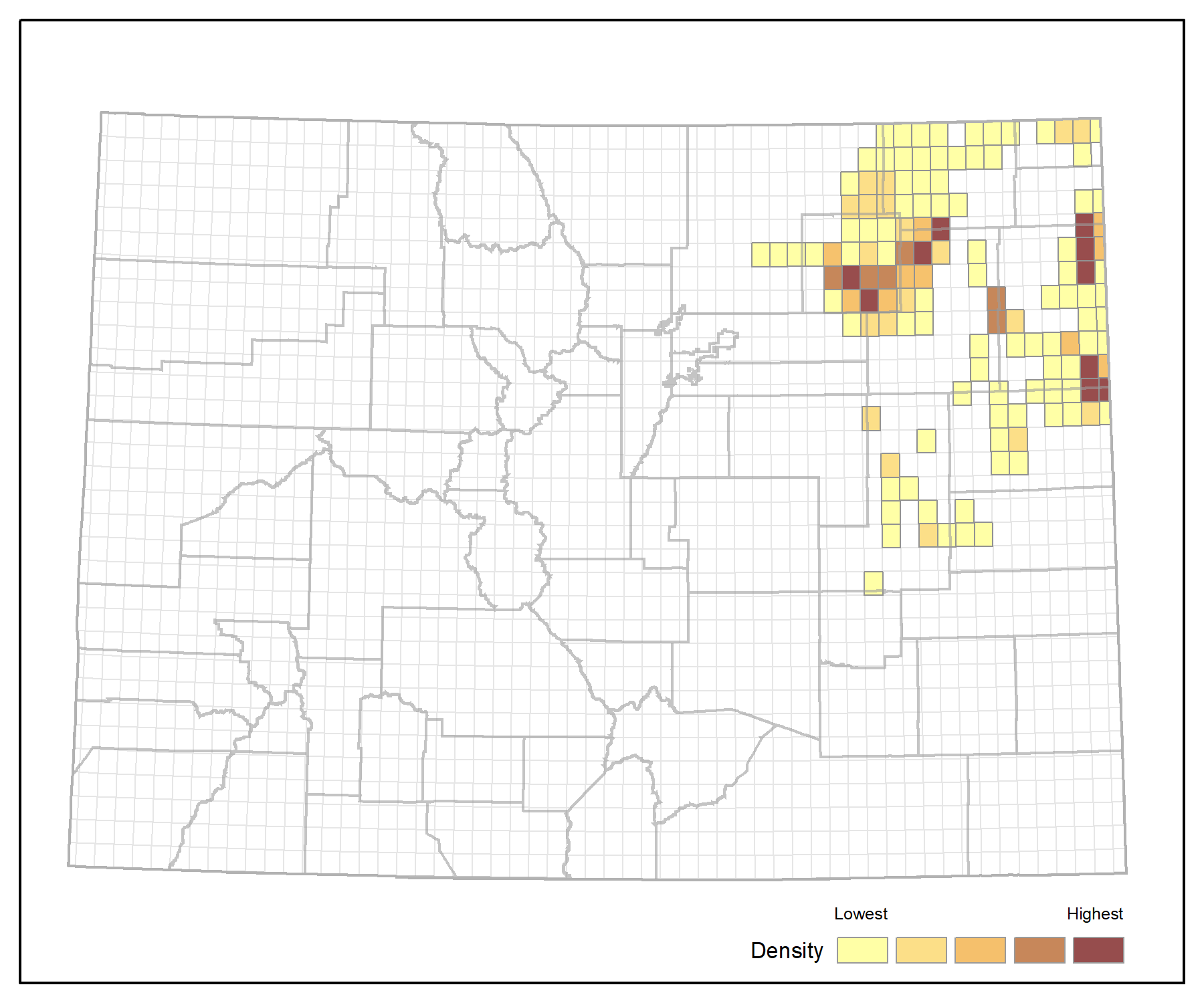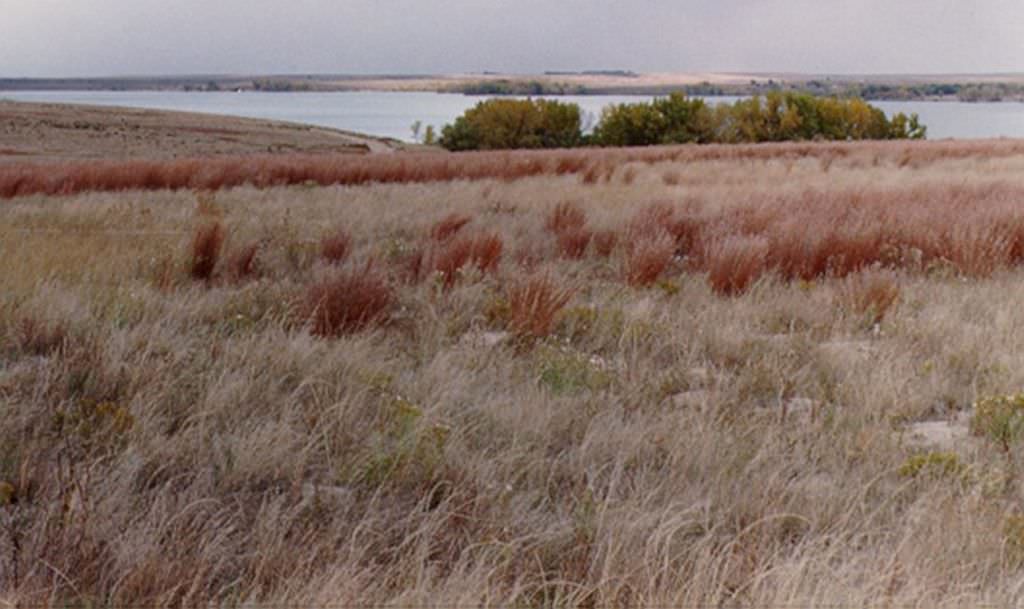Central Mixedgrass Prairie
Click link below for details.
General Description
The mixedgrass or midgrass prairie system ranges from South Dakota to northern Texas and is bordered by the shortgrass prairie on the western edge and the tallgrass prairie to the east. Although the greater part of the mixedgrass prairie lies to the east of Colorado, the western extent of this system has probably moved in and out of what is now eastern Colorado during much of the Holocene, as climatic conditions alternated between wetter and drier. In the sandhills of eastern Colorado, midgrass prairie dominated large areas in the early years of the 1900s. By the late 1940s, most of these communities had been replaced by shortgrass or sandsage communities, due to the effects of grazing and drought. Due to its position on the periphery of the range of the midgrass prairie ecological system, Colorado has probably never supported extensive tracts of this type. Occurrences are typically dominated by warm-season grasses of medium height, including little bluestem (Schizachyrium scoparium), sideoats grama (Bouteloua curtipendula), western wheatgrass (Pascopyrum smithii), with additional midgrass or shortgrass species often present, and a diverse forb component.
Diagnostic Characteristics
Good examples of this ecological system are rare in Colorado. Conservation Reserve Program (CRP) lands often have a superficial appearance of mixedgrass prairie because they are seeded with little bluestem. In addition to the dominance of mid-height grass species, especially little bluestem, the mixedgrass prairie should include a diverse forb component, occasional shrub species, and limited areas of bare ground.
Similar Systems
Western Great Plains Sandhill Steppe: Remnant stands of mixedgrass prairie are intermingled with areas of sandy soil and stabilized dune-fields that are dominated by sand sagebrush. These areas may once have been mixedgrass prairie under wetter climatic conditions.
Western Great Plains Shortgrass Prairie: Shortgrass prairie may include stands of mid-height grasses, but, in general is drier, dominated by blue grama, and typically with more areas of sparser vegetation cover. Some areas that are now shortgrass prairie may have supported mixedgrass prairie under wetter climatic conditions.
Northwestern Great Plains Mixedgrass Prairie: Mid-height grasses are also characteristic of these grasslands to the north. A few stands of this type may occur along the Colorado-Wyoming border, but in general these would not be representative of the system.
Range
Regions characterized by loess soils in west-central Kansas and central Nebraska, the Red Hills region of south-central Kansas and northern Oklahoma are all included in this system. Colorado occurrences are currently restricted to small areas in the northeastern part of the state, near the border with Nebraska or Kansas.
Ecological System Distribution

Spatial Pattern
Although this system forms the matrix vegetation in parts of the Central Mixedgrass Prairie ecoregion, it is a large patch system in Colorado.
Environment
The Central Mixedgrass Prairie occurs in a semi-arid climate that is intermediate between the drier shortgrass region to the west, and the wetter tallgrass region to the east. Differences in topography and soil characteristics occur across the range of this system. It is often characterized by rolling to extremely hilly landscapes with soils developed from loess, shale, limestone or sandstone parent material. In Colorado, Mollisol or Entisol soils are most prevalent and range from silt loams to sand, with sandy loams most common. Loess-derived soils are typical of these prairies. Loess is the fine rock powder that resulted from the grinding of rock beneath the ice sheet that covered much of North America 18,000 years ago. As the ice melted, wind-blown loess was deposited throughout the midwest. Loess deposits are common, but because these soils are fertile and easily tilled, there are now few deep deposits with undisturbed native vegetation.
Vegetation
Because of its position between two other prairie systems, this system contains elements from both shortgrass and tallgrass prairies, which combine to form the midgrass prairie ecological system throughout its range. The majority of mixedgrass associations in this system are dominated by little bluestem (Schizachyrium scoparium) or western wheatgrass (Pascopyrum smithii), although other grass species such as sideoats grama (Bouteloua curtipendula), big bluestem (Andropogon gerardii), needle-and-thread (Hesperostipa comata), blue grama (Bouteloua gracilis), prairie Junegrass (Koeleria macrantha), and threeawn (Aristida spp.) are often present. Numerous forb and sedge (Carex spp.) species can also occur within the mixedgrass system in the Western Great Plains. Although forbs do not always significantly contribute to the canopy, they should be an important part of the community. Some dominant forb species include sunflower (Helianthus spp.), blacksamson echinacea (Echinacea angustifolia), upright prairie coneflower (Ratibida columnifera), dotted blazing star (Liatris punctata), slimflower scurfpea (Psoralidium tenuiflorum), rush skeletonplant (Lygodesmia juncea), and ragweed (Ambrosia psilostachya). Prairie moonwort (Botrychium campestre) is found in some areas. Shrubs can occur in areas protected from fire due to topographic conditions. Non-native species are common in many occurrences.
- CEGL001756 Bouteloua gracilis - Bouteloua dactyloides Grassland
- CEGL002037 Hesperostipa comata - Bouteloua gracilis - Carex filifolia Grassland
- CEGL001321 Krascheninnikovia lanata / Bouteloua gracilis Dwarf-shrub Grassland
- CEGL001573 Panicum obtusum - Bouteloua dactyloides Wet Meadow
- CEGL001579 Pascopyrum smithii - Bouteloua gracilis - Carex filifolia Grassland
- CEGL001578 Pascopyrum smithii - Bouteloua gracilis Grassland
- CEGL001368 Sarcobatus vermiculatus / Sporobolus airoides Wet Shrubland
- CEGL002036 Schizachyrium scoparium - Bouteloua curtipendula Loess Mixedgrass Grassland
- CEGL001594 Schizachyrium scoparium - Bouteloua curtipendula Western Great Plains Grassland
Associated Animal Species
Although there are no animal species which are strictly endemic to midgrass prairie, grassland birds such as Chestnut-collared Longspur (Calcarius ornatus), Lark Bunting (Calamospiza melanocorys), Cassin's Sparrow (Peucaea cassinii), and Grasshopper Sparrow (Ammodramus savannarum) do use these mid-height grasslands for major portions of their life cycle. Greater Prairie Chicken (Tympanuchus cupido) was likely historically common in this habitat. Both mule deer (Odocoileus hemionus) and whitetail deer (Odocoileus virginianus), as well as black-tailed jackrabbit (Lepus californicus), cottontails (Sylvilagus spp.), olive-backed pocket mouse (Perognathus fasciatus), and pocket gophers (Thomomys spp.) are typical mammals of these grasslands. Plains leopard frog (Lithobates blairi) and ornate box turtle (Terrapene ornata ornata) can also be found in this system.
Dynamic Processes
The distribution, species richness and productivity of plant species within the midgrass ecological system is controlled primarily by environmental conditions, especially soil moisture and topography. The relative dominance of the various grass and forb species within different associations in the system can strongly depend on the history and degree of natural or human disturbance. Although the greater part of the mixedgrass prairie lies to the east of Colorado, the western extent of this system has probably moved in and out of what is now eastern Colorado during much of the Holocene, as climatic conditions alternated between wetter and drier. Periodic drought, fire, and grazing were historically the primary processes occurring within the system. In larger occurrences (now outside Colorado) fire and grazing can occur at spatial and temporal scales approaching those at which they naturally occurred, but Colorado occurrences are not currently of adequate size to support these processes. The diversity in this mixedgrass system likely reflects both the short- and long-term responses of the vegetation to these often concurrent disturbance regimes.
Management
As much as 70% of the original extent of these mixedgrass prairies has been lost by conversion to agriculture and other disturbance. Non-native species are common to dominant in some occurrences. Grazing tends to favor the shortgrass species such as blue grama, and may change the balance of dominant species. Fire suppression and overgrazing can lead to the invasion of this system by woody species such as eastern redcedar (Juniperus virginiana). The extent of this type in Colorado has historically been closely tied to climatic conditions, expanding during wetter times and contracting under drier conditions. Warmer summer nighttime low temperatures and/or extended periods of drought are likely to eliminate this type from Colorado, and, if fire frequency remains low, allow the establishment of woody species, with the potential for conversion to a more arid grassland type or savanna.
References
- MCGinnies, W. J., H. L. Shantz, and W. G. McGinnies. 1991. Changes in Vegetation and Land Use in Eastern Colorado: A Photographic Study, 1904 to 1986. U. S. Department of Agriculture, Agricultural Research Service, ARS-85, 165 pp.
- Weaver, J.E. 1960. Comparison of vegetation of Kansas-Nebraska drift-loess hills and loess plains. Ecology 41:73-88.








